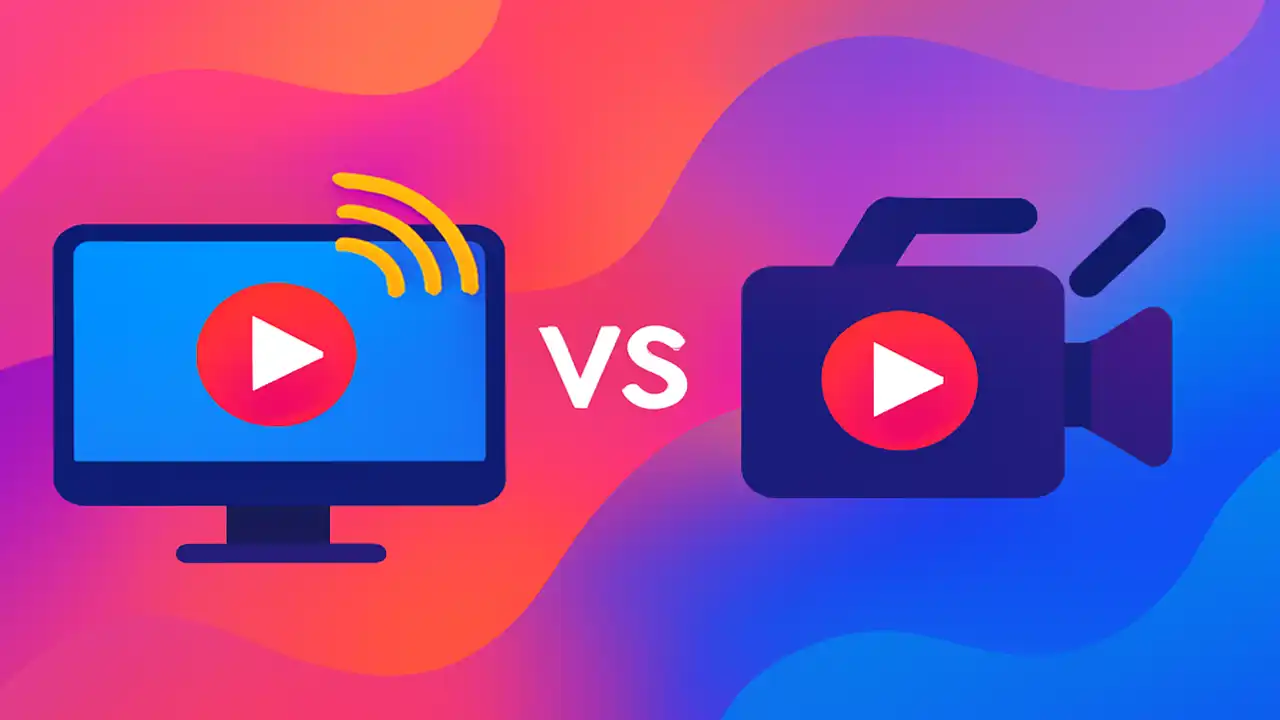Live streaming offers real-time engagement, while recorded video provides polished, SEO-friendly content. This guide helps you choose the best video strategy for your audience and goals with expert tips and actionable insights.
Live Streaming vs Recorded Video: Which Content Strategy Is Right for You?

Introduction: Why Choosing the Right Video Content Strategy Matters
In today’s fast-paced digital world, video content dominates online engagement. Whether you’re a business owner, content creator, or marketer, choosing between live streaming and recorded video is a critical decision that impacts your audience reach, engagement, and conversion rates. Understanding the differences, benefits, and drawbacks of these two popular video strategies can help you tailor your content plan for maximum effectiveness.
This article dives deep into live streaming vs recorded video, exploring which content strategy best suits your goals, resources, and audience preferences. By the end, you’ll have actionable insights to confidently decide whether to go live or pre-record your videos.
Keywords: live streaming, recorded video, content strategy, video marketing, audience engagement, video content types, live streaming benefits, recorded video advantages
Understanding Live Streaming and Recorded Video: A Comprehensive Overview
What is Live Streaming?
Live streaming refers to broadcasting video content in real-time over the internet. Platforms like YouTube Live, Facebook Live, Twitch, and Instagram Live allow creators to interact directly with their audience as events unfold. The immediacy and authenticity of live streaming foster strong connections and high engagement levels.
Key Features of Live Streaming:
- Real-time interaction via comments, chats, and reactions
- Spontaneous and authentic content delivery
- Limited editing or post-production
- Requires stable internet and technical setup
What is Recorded Video?
Recorded video involves creating content ahead of time, editing it for quality, and then publishing it on platforms such as YouTube, Vimeo, or websites. This method allows creators to polish their message, add graphics, subtitles, and ensure high production value.
Key Features of Recorded Video:
- Pre-planned and edited content
- Ability to optimize for SEO with descriptions and metadata
- Suitable for evergreen content
- More control over quality and presentation
Pros and Cons: Live Streaming vs Recorded Video
| Aspect | Live Streaming | Recorded Video |
|---|---|---|
| Engagement | High engagement through live interaction | Engagement through comments but delayed |
| Authenticity | Genuine, unedited, real-time connection | Controlled, scripted, polished |
| Flexibility | Less flexible, technical issues possible | Highly flexible with editing and re-shoots |
| SEO Benefits | Can boost real-time engagement metrics | Better long-term SEO via optimized metadata |
| Content Longevity | Often ephemeral unless saved and repurposed | Evergreen, reusable content |
| Resource Requirement | Requires live setup and quick responses | Requires editing skills and more production time |
Practical Tips and Techniques for Choosing Your Video Content Strategy
When to Use Live Streaming
- Launching a new product or service and wanting instant feedback
- Hosting Q&A sessions, webinars, or interactive tutorials
- Building a loyal community with regular live shows
- Capitalizing on trending topics or real-time events
When to Use Recorded Video
- Delivering detailed tutorials or courses requiring clarity and polish
- Sharing case studies, testimonials, or explainer videos
- Creating evergreen content that stays relevant over time
- Optimizing for search engines with detailed metadata and transcripts
Hybrid Strategy: Combining Both for Maximum Impact
Many successful brands combine live streaming with recorded video. For example, a live event can be recorded, edited, and repurposed into shorter clips for social media or YouTube, maximizing content lifespan and reach.
Leveraging Internal and External Links to Boost SEO
In your content marketing strategy, always include relevant internal links to related blog posts or product pages on your website. For example, link to your guides on “How to Optimize Video for SEO” or “Best Video Marketing Tools in 2025.”
Also, incorporate authoritative external links to credible sources such as industry reports, platform documentation, or well-known digital marketing blogs like Moz or HubSpot. This boosts your article’s credibility and search engine trustworthiness.
SEO Best Practices for Video Content
- Keyword Research: Use tools like Google Keyword Planner or Ahrefs to find high-traffic keywords such as live streaming tips, best recorded video strategies, and video marketing 2025.
- Meta Descriptions: Craft compelling meta descriptions containing primary keywords to improve click-through rates.
- Alt Text for Images: Use descriptive alt text for all images that includes relevant keywords to enhance image search rankings.
- Transcripts and Captions: Adding transcripts and captions improves accessibility and helps search engines index your video content better.
- Page Speed: Ensure fast loading times for video pages by compressing files and using reliable hosting.
Image Optimization for Better User Experience and SEO
Including relevant, high-quality images like comparison charts, screenshots of live streams, or video production setups can make your article more engaging. For each image:
- Use descriptive filenames (e.g., live-streaming-vs-recorded-video-chart.jpg)
- Add alt text such as “Comparison chart between live streaming and recorded video strategies”
- Optimize image size without losing quality for faster page loading
Conclusion and Call to Action (CTA)
Choosing between live streaming and recorded video ultimately depends on your goals, audience, and resources. Live streaming offers unparalleled real-time engagement and authenticity, while recorded videos provide polished, evergreen content with strong SEO potential. Many creators benefit from a hybrid approach, blending the strengths of both strategies.
Ready to elevate your video marketing? Start experimenting with live streams or create a polished recorded video today! Share your experiences or questions in the comments below, and don’t forget to subscribe for more expert insights on video content strategies.
Continuous Improvement and Analysis
To maintain and improve your video content strategy:
- Regularly analyze performance metrics such as watch time, engagement rates, and SEO rankings.
- A/B test different formats, titles, and keywords.
- Gather audience feedback through surveys or comments.
- Update your content periodically to keep it relevant and aligned with algorithm changes.
By continuously optimizing, you’ll ensure your video marketing efforts stay effective and ahead of the competition.